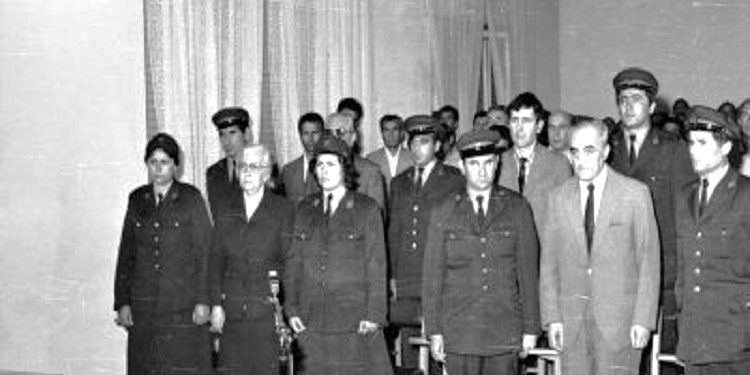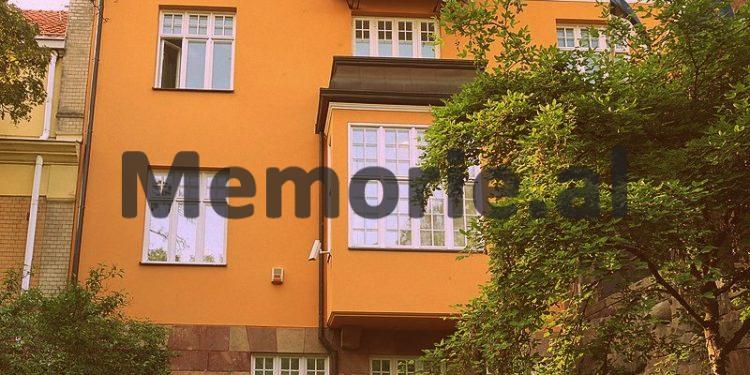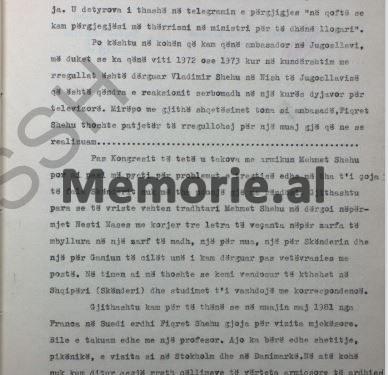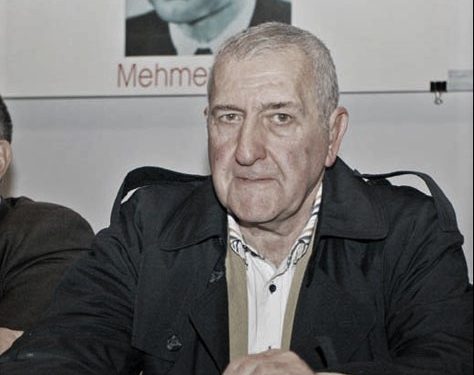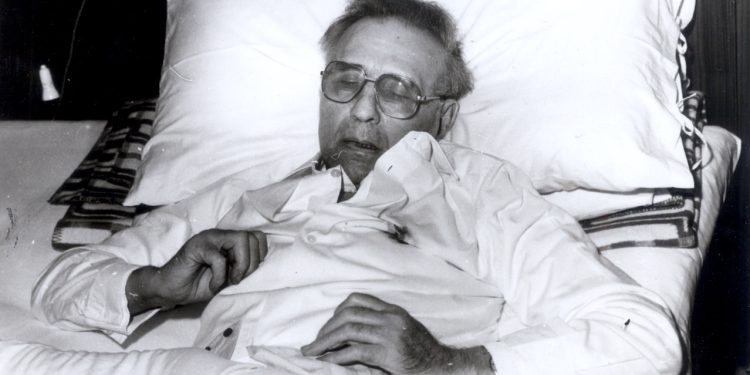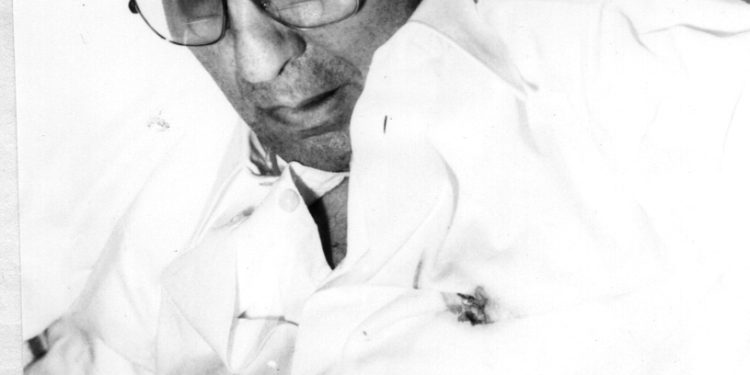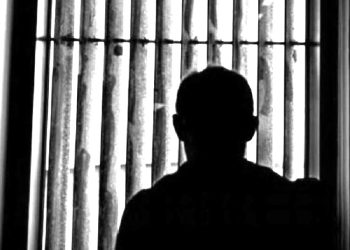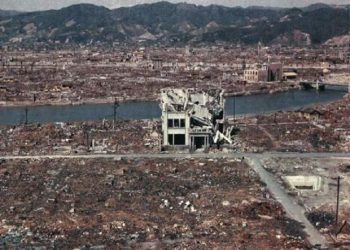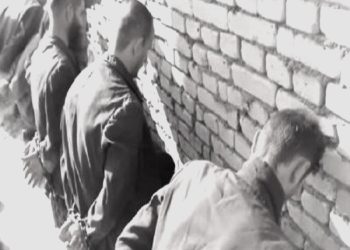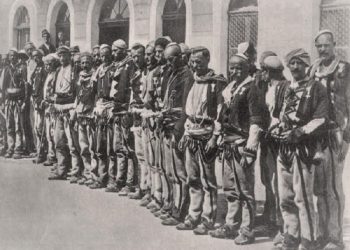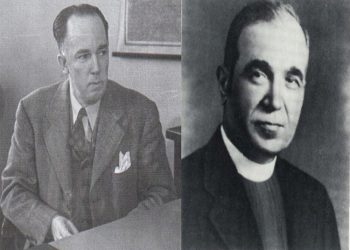By Dashnor Kaloçi
Part thirty-two
Memorie.al / Forty-three years ago, at dawn on December 18, 1981, the Albanian Prime Minister Mehmet Shehu, who had held that position since 1953, was found dead in his bedroom (according to the official version, from a “pistol shot”), in the villa where he lived with his family, at the entrance to the “Block” of the high leadership of the Party of Labour, just a few meters from the building of the Central Committee of the Party of Labour and also from the villa of Enver Hoxha, number 31. Even though more than four decades have passed since that day, considered one of the most serious and also most publicized events of that regime, there is still no clear and accurate version regarding what happened to the former Albanian Prime Minister, Mehmet Shehu, on the night before December 18, 1981! However, even after the 1990s, dozens of testimonies and archival documents have been made public regarding that event, “the murder or suicide of Mehmet Shehu,” which continues to be the subject of numerous debates and discussions, further shrouding the truth around it in mystery!
Starting from this fact, in the context of publishing dozens of testimonies and files with archival documents from the secret fund of the former State Security and the Ministry of Internal Affairs, or even the Central Committee of the Party of Labour, which we have published in these three decades after the collapse of Enver Hoxha’s communist regime and that of his successor, Ramiz Alia, Memorie.al has obtained the voluminous file “of the enemy and poly-agent Mehmet Shehu,” which was extracted from the secret fund of the former State Security at the Ministry of Internal Affairs (now declassified and part of the fund of the Authority for the Information of the Documents of the former State Security), where with a few small exceptions, the vast majority of them has never seen the light of publication and is being published for the first time complete with the relevant facsimiles.
In this file, in addition to the testimonies in interrogation from witnesses or defendants, there are also complete the expert reports of the operational-investigative group that was established immediately on the morning of December 18, 1981, led by Koço Josifi (head of the Investigation Directorate of the Ministry of Internal Affairs of Tirana), forensic doctors Dr. Fatos Hartito and Docent Bashkim Çuberi, the Prime Minister’s doctors, Milto Kostaqi and Llesh Rroku, the criminalist expert from the Central Forensic Laboratory of the Ministry of Internal Affairs, Estref Myftari, assisted by high officials from that ministry, Deputy Minister Xhule Çiraku, head of the Investigation Directorate at the Ministry of Internal Affairs Elham Gjika, and the deputy director of the Tirana Directorate of Internal Affairs, Lahedin Bardhi.
This file also contains the testimonies of the family members of the former Prime Minister Mehmet Shehu, service personnel, and his escort group, as well as all the other people who were summoned and testified about that event.
However, even though we are dealing with archival documents, it should be emphasized that knowing how the communist regime operated before the 1990s, we cannot claim absolute truthfulness regarding what is written there, as not only the witnesses and defendants who have given their testimonies, but also some of the investigators of this case (primarily after the 1990s) have made it known that these were obtained under pressure, intimidation, and torture, both physical and psychological, even further, where some of the investigators wrote them themselves, and the witnesses or defendants simply signed them.
Moreover, for some of the defendants in this investigative process, specifically in the case of Fiqret Shehu, the questions were drafted by Enver Hoxha himself (in his handwriting) and were sent to the investigators through the Minister of Internal Affairs, Hekuran Isai (which we have published with the relevant facsimiles in previous writings), and all of this aimed to enable “the discovery of the hostile group of poly-agent Mehmet Shehu,” in order to justify his suicide (according to the official version)!
In this context of the dictator Enver Hoxha’s paranoia, the following individuals were arrested and placed on trial: Kadri Hazbiu (former member of the Political Bureau of the Central Committee of the Party of Labour and Minister of Internal Affairs and Defence), Feçor Shehu (former Director of State Security and Minister of Internal Affairs), Nesi Nase (former Minister of Foreign Affairs), Llambi Ziçishti (former Minister of Health), Llambi Peçini (former head of the Directorate of Protection and Physical Security of the high leadership of the Party of Labour), Elham Gjika (former head of the Investigations of the Ministry of Internal Affairs), Gani Kodra (former head of the Directorate of Protection and Physical Security of the high leadership of the Party of Labour and the family of Mehmet Shehu), Kristofor Martiro (former investigator of the “hostile group of Beqir Balluku”), Ali Çeno (former head of the escort group of Prime Minister Mehmet Shehu), Xhavit Ismailaga (former barber of Hotel “Dajti”), Idriz Seiti (former Colonel of State Security, head of the Departments of Internal Affairs in Kukës and Lezhë, and head of department in the Ministry of Internal Affairs for the protection, security, and execution of anti-party individuals), Lirim Pëllumbi (former head of the Department of Internal Affairs for the district of Durrës), Qamil Mane Islami (former Colonel in the Directorate of Camps and Prisons of the Ministry of Internal Affairs), Duro Shehu (brother of Mehmet Shehu, former commissioner in the Directorate of Military Aviation of the Ministry of Defence), Fiqret Shehu, the wife of Mehmet Shehu, along with their two sons, Bashkimi and Skënderi, etc.
From this “hostile group,” the first four (Kadri Hazbiu, Feçor Shehu, Llambi Ziçishti, and Llambi Peçini) were sentenced to death and executed, while the others received heavy prison sentences, from which they were only released in 1991, with the exception of Fiqret Shehu, who died in prison in 1987, under mysterious and still unresolved circumstances, as well as the eldest son of the Shehu family, Vladimir, who also died under mysterious circumstances still unresolved, in the city of Gramsh (the official version: suicide), where he had been interned with his family in January 1982. For more information about this event, etc., the documents in question provide details, which we are publishing along with the relevant facsimiles and photos.
Continued from the previous issue
MINUTES OF THE INTERROGATION OF DHIMITER LAMANI, FORMER AMBASSADOR OF ALBANIA IN STOCKHOLM, SWEDEN, BY THE INVESTIGATORS OF THE MINISTRY OF INTERNAL AFFAIRS, BASHKIM ASLLANI AND SKENDER MYFTARI
MINUTES
(Of the witness interrogation)
Today, January 23, 1983, in Tirana.
We, the investigators of the Ministry of Internal Affairs, Bashkim Asllani and Skender Myftari, are taking testimony from Dhimitër Kleanth Lamani, born in 1918, with higher education, residing in Neighborhood No. 8, “Agimi” Buildings, Staircase 26, Apt. 404, retired, member of the Party of Labour of Albania, not previously convicted.
The witness has been warned of his legal responsibility under Article 202 of the Penal Code of the People’s Socialist Republic of Albania for giving false testimony.
WITNESS
Dhimitër Lamani
Regarding the matter, I can say the following: In April 1979, the enemy Nesti Nase called me and informed me that I was to be the ambassador in Sweden. That month, I departed for Sweden. Around June or July, Nesti Nase informed me via telegram to take an interest in Sweden so that they would grant me five scholarships for postgraduate studies. I applied, and they were approved. Later, Nesti Nase sent me a personal letter informing me that the son of Mehmet Shehu, Skënder Shehu, would come for studies and provided me with a series of instructions regarding maintaining secrecy and a pseudonym, as we needed to inform a deputy minister of Foreign Affairs in Sweden about him.
He also instructed me to find three apartments because Skënder would be accompanied by two families, Gani Kodra’s and the driver Thanas Kosta. From the enemy Nesti Nase, we even received an order that just to pay the landlords as an advance for finding three apartments together, we would spend 20 thousand dollars or 100 thousand kronor. Since we found another option, we did not pay them.
During the time Skënder Shehu was in Sweden, I noticed that, contrary to regulations, substantial expenses were incurred for him and his companions. For example, it was inappropriate for him to be accompanied by two families that were paid for by the state! As a result, three apartments were needed, and it was quite difficult to find them at that time, and the Swedes charged a lot for them.
In addition, there were numerous moves made on their part, in France, Germany, and Denmark. They came outside the regulations in Albania, not on the shortest routes, but the itineraries, according to Nesti’s written orders, were set by themselves, moving from country to country, e.g., from Sweden to Denmark, Switzerland, Italy, and Albania. On one occasion, we went as far as Copenhagen, and there we crashed and destroyed the car.
Skënder called me on the phone not to inform anyone, but I sent a telegram to Nesti. When he arrived, he bought a new car at Nesti’s order. In the telegram, Nesti stated; the car should be ready before Arjan Bogova, Skënder’s pseudonym, arrives. Therefore, in these trips Skënder took with his entourage, large sums of money were spent. The trips were always in first-class accommodations, which are very expensive.
Just for the new car we bought, around 10 thousand dollars were spent. By Nesti Nase’s order, other expenses for entertainment incurred by Skënder Shehu and Gani Kodra, such as for cinema, theater, and rentals, were covered by the embassy as expenses made by the embassy. Moreover, contrary to regulations, by Nesti Nase’s order, several times, Gani Kodra’s wife came from Sweden to Albania, and their children came from Albania to Sweden. When various inspectors came to Sweden from the ministry and checked the embassy’s financial activities, they detected these violations.
Androkli Andoni told me that he would report these violations to the ministry and held me responsible as the ambassador. I told Androkli that while he reports to the ministry, I had received written orders from Nesti Nase regarding all of this.
It is true that these were called expenses for the embassy, but the state and the embassy gained no benefit from them because these very large expenses were incurred solely for the interests of individuals and the pleasures of Skënder Shehu and his companions.
Fiqret Shehu often called me on the phone to fulfill various requests from Skënder, but I told him that requests should be made officially and that Nesti Nase should instruct me about them. I noticed that for what Fiqreti told me on the phone, the next day a telegram with the order from Nesti Nase would arrive.
Around the middle of 1980, I came for a seminar in Tirana. In one meeting, I told Nesti Nase: “There are so many expenses, and I have exceeded the embassy’s budget!” I was referring specifically to the above-mentioned expenses. Nesti responded immediately: “Dhimitër, I won’t leave you without any money; therefore, you don’t need to raise such problems! These need to be made, and we will cover them!”
When I was the ambassador in Paris, at the end of 1980, Skënder Shehu, the son of Mehmet Shehu, was supposed to come to France for studies. Despite our efforts as an embassy, the French side did not accept him! It was not mentioned that he was the son of the Prime Minister. At that time, Nesti sent me a telegram, telling me that nothing would justify me from responsibility if I did not resolve it. From the telegram, I understood the pressure that Mehmet Shehu was exerting through Nesti Nase, but nevertheless, I had nothing to do.
I felt compelled to tell him in my response telegram: “If I am responsible, call me to the ministry to give an account.” Similarly, during my time as an ambassador in Yugoslavia, in 1972 or 1973, in contravention of the rules, Vladimir Shehu was sent to Niš in Yugoslavia, which is the center of Serbian reaction, for a two-week course on televisions. However, despite our concerns as an embassy, Fiqret Shehu insisted that it must be resolved within a month, which we did not realize.
After the 8th Congress, I met with the enemy Mehmet Shehu, but after he asked me about trade issues, he also told me to send regards to Skënder, without telling me anything important. Furthermore, before the traitor Mehmet Shehu took his own life, he sent me three separate letters through Nesti Nase via courier, in envelopes, sealed in a larger envelope—one for me, one for Skënder, and one for Ganiu, which I sent after his suicide by mail.
In my letter, he mentioned that we had decided for Skënder to return to Albania and continue his studies by correspondence. I should also mention that in May 1981, Fiqret Shehu came from France to Sweden, supposedly for a medical visit. In fact, we even met with a professor. She made outings, picnics, and visits in Stockholm and Denmark.
At that time, I knew nothing about the true hostile intentions behind Fiqret Shehu’s visit to Sweden. However, during that period, apart from the constant phone calls from the family of the enemy Mehmet Shehu, they continuously inquired about Fiqret Shehu by telegram, as did Nesti Nase.
I do not recall anything else.
I have read the minutes; the statements are written correctly; I sign with my signature. Memorie.al
Witness Investigators
Dhimitër Lamani Bashkim Asllani Skënder Myftari
To be continued in the next issue.






